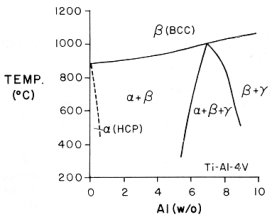 |
 |
 |
 |
 |
 |
 |
 |
 |
 |
 |
 |
 |
 |
 |
 |
|
|
|
|
|
|
|
|
|
|
|
|
|
|
|
|
|
|
Corrosion
& Environmental Degradation |
|
|
|
|
|
|
|
|
|
|
|
|
|
|
|
|
|
|
|
|
|
|
|
|
|
|
|
|
|
|
|
|
|
|
|
|
|
|
|
|
|
|
|
|
|
|
|
|
|
|
|
|
|
|
|
|
|
|
·
Titanium
alloys (Ti - 6% Al - 4% V) also have excellent corrosion resistance and
the material is a good choice for fabricating both the plates and the attachment
screws.
·
For
applications requiring wear resistance, the addition of molybdenum and
tin to the alloy (TiSnMoAl) was found to be an advantage.
·
The
phase diagram shows the thermodynamically stable zones in the Ti-Al binary system.
Aluminum addition increases the temperature at which the α
to β
phase transition occurs. |
|
|
|
|
|
|
|
|
|
|
|
|
|
|
|
 |
|
|
|
|
|
|
|
|
|
|
|
|
|
|
|
|
|
|
From:
J. B. Park, "Biomaterials Science and Engineering," Plenum (1984) |
|
|
|
|
|
|
|
|
|
|
|
|
|
|
|
|
|
|
|
|
|
|
|
|
|
|
|
|
|
|
|
|
|
·
Additions
of Cr, V, Mo, and Ta, lower the α
to β
transformation temperature and kinetically permit more of the β-phase
to exist (metastable) at body temperature.
· Additions
of Sn and Zr do not influence the transition temperature but do increase
the strength of the room temperature alloy.
· Titanium
corrosion products are not bioactive, whereas Ni and Cr ions from the corrosion
of the stainless steel can concentrate in tissue near the implant. These
materials have been shown to be carcinogenic in animals. |
